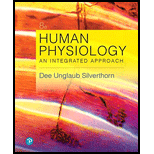
Pearson eText Human Physiology: An Integrated Approach -- Instant Access (Pearson+)
8th Edition
ISBN: 9780135212905
Author: Dee Silverthorn
Publisher: PEARSON+
expand_more
expand_more
format_list_bulleted
Concept explainers
Question
Chapter 9, Problem 3RQ
Summary Introduction
Introduction: The central nervous system includes the brain and the spinal cord. Many different layers of nervous tissue are present in the central nervous system. These layers are nearby to a fluid filled central cavity that is lined with epithelium. The central nervous system also consists of neurons and concerned glial cells.
Expert Solution & Answer
Want to see the full answer?
Check out a sample textbook solution
Students have asked these similar questions
What is the label ?
Can you described the image? Can you explain the question as well their answer and how to get to an answer to an problem like this?
glg 112 mid unit assignment Identifying melting processes
Chapter 9 Solutions
Pearson eText Human Physiology: An Integrated Approach -- Instant Access (Pearson+)
Ch. 9.2 - Prob. 1CCCh. 9.3 - Name the four kinds of glial cells found in the...Ch. 9.3 - Prob. 3CCCh. 9.3 - Prob. 4CCCh. 9.3 - Prob. 5CCCh. 9.3 - Prob. 6CCCh. 9.3 - Prob. 7CCCh. 9.3 - Prob. 8CCCh. 9.3 - Prob. 9CCCh. 9.3 - In the late 1800s, the scientist Paul Ehrlich...
Ch. 9.3 - Prob. 11CCCh. 9.4 - Prob. 12CCCh. 9.4 - Prob. 13CCCh. 9.5 - Are the following white matter or gray matter? (a)...Ch. 9.5 - Using the information from Table 9.1, describe the...Ch. 9.5 - In anatomical directional terminology, the...Ch. 9.5 - Prob. 17CCCh. 9.5 - Prob. 18CCCh. 9.5 - Prob. 19CCCh. 9.5 - Prob. 20CCCh. 9.6 - Prob. 21CCCh. 9 - Prob. 1RQCh. 9 - Prob. 2RQCh. 9 - Prob. 3RQCh. 9 - In vertebrates, the central nervous system is...Ch. 9 - Prob. 5RQCh. 9 - Prob. 6RQCh. 9 - Prob. 7RQCh. 9 - Prob. 8RQCh. 9 - Prob. 9RQCh. 9 - Prob. 10RQCh. 9 - Prob. 11RQCh. 9 - What does cerebral lateralization refer to? What...Ch. 9 - Match each of the following areas with its...Ch. 9 - Name the 12 cranial nerves in numerical order and...Ch. 9 - Name and define the two major phases of sleep. How...Ch. 9 - List several homeostatic reflexes and behaviors...Ch. 9 - Prob. 17RQCh. 9 - What are the broad categories of learning? Define...Ch. 9 - Prob. 19RQCh. 9 - Prob. 20RQCh. 9 - Prob. 21RQCh. 9 - What are the three brain systems that regulate...Ch. 9 - Explain the role of Wernickes and Brocas areas in...Ch. 9 - Compare and contrast the following concepts: a....Ch. 9 - What properties do motivational states have in...Ch. 9 - Prob. 26RQCh. 9 - Prob. 27RQCh. 9 - Prob. 28RQCh. 9 - Mr. Andersen, a stroke patient, experiences...Ch. 9 - Prob. 30RQCh. 9 - Prob. 31RQCh. 9 - Prob. 32RQCh. 9 - Prob. 33RQ
Knowledge Booster
Learn more about
Need a deep-dive on the concept behind this application? Look no further. Learn more about this topic, biology and related others by exploring similar questions and additional content below.Similar questions
- Explain how the hormones of the glands listed below travel around the body to target organs and tissues : Pituitary gland Hypothalamus Thyroid Parathyroid Adrenal Pineal Pancreas(islets of langerhans) Gonads (testes and ovaries) Placentaarrow_forwardWhat are the functions of the hormones produced in the glands listed below: Pituitary gland Hypothalamus Thyroid Parathyroid Adrenal Pineal Pancreas(islets of langerhans) Gonads (testes and ovaries) Placentaarrow_forwardDescribe the hormones produced in the glands listed below: Pituitary gland Hypothalamus Thyroid Parathyroid Adrenal Pineal Pancreas(islets of langerhans) Gonads (testes and ovaries) Placentaarrow_forward
- Please help me calculate drug dosage from the following information: Patient weight: 35 pounds, so 15.9 kilograms (got this by dividing 35 pounds by 2.2 kilograms) Drug dose: 0.05mg/kg Drug concentration: 2mg/mLarrow_forwardA 25-year-old woman presents to the emergency department with a 2-day history of fever, chills, severe headache, and confusion. She recently returned from a trip to sub-Saharan Africa, where she did not take malaria prophylaxis. On examination, she is febrile (39.8°C/103.6°F) and hypotensive. Laboratory studies reveal hemoglobin of 8.0 g/dL, platelet count of 50,000/μL, and evidence of hemoglobinuria. A peripheral blood smear shows ring forms and banana-shaped gametocytes. Which of the following Plasmodium species is most likely responsible for her severe symptoms? A. Plasmodium vivax B. Plasmodium ovale C. Plasmodium malariae D. Plasmodium falciparumarrow_forwardStandard Concentration (caffeine) mg/L Absorbance Reading 10 0.322 20 0.697 40 1.535 60 2.520 80 3.100arrow_forward
arrow_back_ios
SEE MORE QUESTIONS
arrow_forward_ios
Recommended textbooks for you
 Medical Terminology for Health Professions, Spira...Health & NutritionISBN:9781305634350Author:Ann Ehrlich, Carol L. Schroeder, Laura Ehrlich, Katrina A. SchroederPublisher:Cengage Learning
Medical Terminology for Health Professions, Spira...Health & NutritionISBN:9781305634350Author:Ann Ehrlich, Carol L. Schroeder, Laura Ehrlich, Katrina A. SchroederPublisher:Cengage Learning Human Biology (MindTap Course List)BiologyISBN:9781305112100Author:Cecie Starr, Beverly McMillanPublisher:Cengage Learning
Human Biology (MindTap Course List)BiologyISBN:9781305112100Author:Cecie Starr, Beverly McMillanPublisher:Cengage Learning



Medical Terminology for Health Professions, Spira...
Health & Nutrition
ISBN:9781305634350
Author:Ann Ehrlich, Carol L. Schroeder, Laura Ehrlich, Katrina A. Schroeder
Publisher:Cengage Learning


Human Biology (MindTap Course List)
Biology
ISBN:9781305112100
Author:Cecie Starr, Beverly McMillan
Publisher:Cengage Learning
